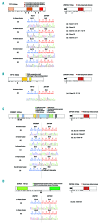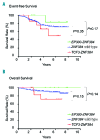ZNF384-related fusion genes define a subgroup of childhood B-cell precursor acute lymphoblastic leukemia with a characteristic immunotype
- PMID: 27634205
- PMCID: PMC5210242
- DOI: 10.3324/haematol.2016.151035
ZNF384-related fusion genes define a subgroup of childhood B-cell precursor acute lymphoblastic leukemia with a characteristic immunotype
Abstract
Fusion genes involving ZNF384 have recently been identified in B-cell precursor acute lymphoblastic leukemia, and 7 fusion partners have been reported. We further characterized this type of fusion gene by whole transcriptome sequencing and/or polymerase chain reaction. In addition to previously reported genes, we identified BMP2K as a novel fusion partner for ZNF384 Including the EP300-ZNF384 that we reported recently, the total frequency of ZNF384-related fusion genes was 4.1% in 291 B-cell precursor acute lymphoblastic leukemia patients enrolled in a single clinical trial, and TCF3-ZNF384 was the most recurrent, with a frequency of 2.4%. The characteristic immunophenotype of weak CD10 and aberrant CD13 and/or CD33 expression was revealed to be a common feature of the leukemic cells harboring ZNF384-related fusion genes. The signature gene expression profile in TCF3-ZNF384-positive patients was enriched in hematopoietic stem cell features and related to that of EP300-ZNF384-positive patients, but was significantly distinct from that of TCF3-PBX1-positive and ZNF384-fusion-negative patients. However, clinical features of TCF3-ZNF384-positive patients are markedly different from those of EP300-ZNF384-positive patients, exhibiting higher cell counts and a younger age at presentation. TCF3-ZNF384-positive patients revealed a significantly poorer steroid response and a higher frequency of relapse, and the additional activating mutations in RAS signaling pathway genes were detected by whole exome analysis in some of the cases. Our observations indicate that ZNF384-related fusion genes consist of a distinct subgroup of B-cell precursor acute lymphoblastic leukemia with a characteristic immunophenotype, while the clinical features depend on the functional properties of individual fusion partners.
Copyright© Ferrata Storti Foundation.
Figures





References
-
- Hunger SP, Mullighan CG. Acute lymphoblastic leukemia in children. N Engl J Med. 2015;373(16):1541–1552. - PubMed
-
- Rieder H, Schnittger S, Bodenstein H, et al. dic(9;20): a new recurrent chromosome abnormality in adult acute lymphoblastic leukemia. Genes Chromosomes Cancer. 1995;13(1):54–61. - PubMed
-
- Moorman AV, Richards SM, Robinson HM, et al. Prognosis of children with acute lymphoblastic leukemia (ALL) and intrachromosomal amplification of chromosome 21 (iAMP21). Blood. 2007;109(6):2327–2330. - PubMed
Publication types
MeSH terms
Substances
LinkOut - more resources
Full Text Sources
Other Literature Sources
Molecular Biology Databases
Miscellaneous

